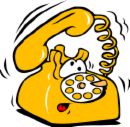This was a question I was asked recently, and my questioner had statistics that were said to prove that body language did not add any real or additional message to the words.
‘I do a great deal of my work on the telephone” she added triumphantly, “and you don’t get much body language there!”
I agreed with her, I totally agreed with her –there is no body language to rely on to inform, inspire or instruct when using the telephone.
But if we are discussing the importance of body language let us not throw the baby out with the bathwater! There seems to have arisen a mistaken belief that non-verbal communication is more important than verbal communication and that up to 60% of the message is received by non-verbal means. Fortunately we have realised that the actual research provednothing of the kind.
But before we decide that we can now all act like automatons, we need to consider carefully what communication is all about. To be effective we need not only to provide the facts and figures, the rational and logical arguments; but we need also to connect with the listener to create an emotional response which makes them receptive to our message.
If you doubt me, recall the last time you listened to a Treasurer’s Report! It’s full of facts and figures; it is rational and logical to an appalling degree. It is more than likely never going to be supported by any body language and it bores the pants off most of us half way through. Unless you have an existing passionate interest in the financial workings of the “Butterfly Chasers Association of Inner Indooroopilly” this is never going to work for you. Actually, even with body language it has very little going for it.
Telemarketers know that holding their listeners’ interest without a visual impact to back up the message is extremely difficult, and they have devised a number of alternative ways to create that emotional impact. Which is why often the first thing you’ll hear is that you’ve won something; appealing to the listener’s self interest is a powerful tool.
But what is missing is that immediacy of feedback – the slight puzzled look that tells you at once that the listener just hasn’t got it; and so we may say it again in different words. We don’t have to ask if they have understood us, it is apparent by their facial expression.
What about if they are hostile to what we are saying? Stance can change to become aggressive, a scowl along with tightening lips will tell you louder than any words can exactly how the person is reacting emotionally to your message.
And that is the power of body language, the impact is immediate. When you use it yourself it can show listeners your own personal involvement in your message; and watching it in others can show you how that message is being received.
Credibility is inbuilt into body language. We watch a person’s face to find out if they are trustworthy. Someone who avoids our eye contact is seen as being evasive, and therefore we instinctively find ourselves disbelieving them. A friendly smile builds up rapport with those we are speaking to which can create in them a willingness to be convinced.
All these little pointers to clear communication are necessary for us to understand the emotional responses to our messages. We need more than the intellectual informative stuff if we are to be truly effective communicators.
And without the visual impact we need to rely on that other emotional tool to persuade our listeners to believe and connect with what we say – and that is our voice.
But even if we include good vocal skills, we are still missing a vital tool in our communication process. It is the visual, the non-spoken messages that we the speaker need to see to know that we have connected with our listeners – and my questioner was right – you don’t get that on the telephone.
Michele @ Trischel



